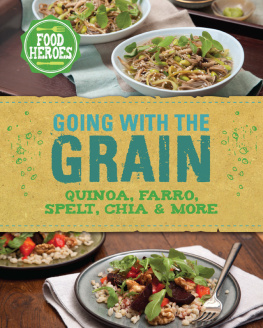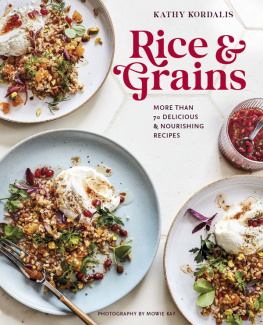

This digital edition first published by Parragon Books Ltd in 2014 and distributed by
Parragon Inc.
440 Park Avenue South, 13th Floor
New York, NY 10016
www.parragon.com/lovefood
LOVE FOOD is an imprint of Parragon Books Ltd
Copyright Parragon Books Ltd 2014
LOVE FOOD and the accompanying heart device is a registered trademark of Parragon Books Ltd in the USA, the UK, Australia, India, and the EU.
All rights reserved. No part of this publication may be reproduced, stored in a retrieval system, or transmitted, in any form or by any means, electric, mechanical, photocopying, recording, or otherwise, without the prior permission of the copyright holder.
10 9 8 7 6 5 4 3 2 1
ISBN 978-1-4723-8640-3
New recipes, introduction, and incidental text written by Christine McFadden
New photography by Noel Murphy
New home economy by Jane Lawrie
Additional design work by Geoff Borin
Internal illustrations by Julie Ingham and Nicola OByrne
Nutritional consultant: Judith Wills
Notes for the Reader
This book uses standard kitchen measuring spoons and cups. All spoon and cup measurements are level unless otherwise indicated. Unless otherwise stated, milk is assumed to be whole, eggs are large, individual vegetables are medium, and pepper is freshly ground black pepper. Unless otherwise stated, all root vegetables should be peeled prior to using.
Garnishes, decorations, and serving suggestions are all optional and not necessarily included in the recipe ingredients or method. Preparation times differ according to the techniques used by different people and the cooking times may also vary from those given. Optional ingredients, variations, or serving suggestions have not been included in the time calculations.
Picture acknowledgments
The publisher would like to thank the following for the permission to reproduce copyright material: Cover illustrations courtesy of iStock.
INTRODUCTION
Slowly but surely, grains have moved from the culinary sidelines to their rightful place as twenty-first-century food heroes. No longer dismissed as mere health foods, they have become must-have ingredients for home cooks, they show up increasingly in food magazines and blogs, and are allocated ever-expanding shelf space in supermarkets. But what exactly are grains? Why all the hype?
Grains, or cereals (from Ceres, the Roman goddess of agriculture), are the seeds of cultivated grasses, such as wheat, rice, and barley. They contain the plants embryo and with it a package of concentrated nutrients to support the new plants growth. There are also so-called pseudo-grains, such as quinoa and amaranth. These are not grasses but share much of the same nutritional characteristics and culinary uses.
Grains are the go-getters of the plant world. They are not picky about where they grow and many positively thrive in scorching sun, sub-zero temperatures, and poor-quality soil. In prehistoric times, grains were one of the first foods that could be stored. They were key to transforming a nomadic society to one that put down roots, and are now a staple food for about half the worlds population.
 | For easy reference, the symbols shown below appear on the recipes in this book: |
 | indicates recipes that are suitable for vegetarians |
 | indicates recipes that do not contain gluten |

THE GRAINS
QUINOA (pronounced keen-wah)
Chenopodium quinoa
Quinoa is native to Peru and Bolivia where it was known as the golden grain of the Incas. Botanically related to beets and spinach, it is one of the hardiest of plants, and trumps the nutrient content of all other grains. It is said to be the only plant food that contains all nine essential amino acids, putting it on a par with animal protein. It is also gluten-free. Not only are its nutritional credentials impeccable, it is also incredibly quick and easy to cook. Use it as a side dish and in a multitude of other dishes, including salads, soups, stews, stuffings, egg dishes, bread, cakes, and desserts.

Shopping
Grains: Minuscule white, red, or black, round seeds with a pale band around the edge.
Flakes: Use in the same way as oat flakes for a hot breakfast cereal.
Puffs: Popped grains eaten as a breakfast cereal.
Flour: Gluten-free, slightly bitter. Needs combining with other flours to make bread and cakes rise.

Cooking
The seeds are naturally coated with bitter saponin that is removed during processing. The seeds should still be rinsed to remove any residue. Put in a fine-meshed strainer under running water and rub with your fingers.
Use 1 part quinoa to 2 parts liquid.
Put in a saucepan with the liquid and a little salt. Bring to a boil, then cover and simmer over low heat for 10 minutes. Remove from the heat but leave the pan covered for another 7 minutes to let the seeds swell. The band around the edge will uncurl like a spiral. Drain off any excess liquid through a fine-meshed strainer. Fluff up with a fork.

Tasting
The seeds have a mild, slightly grassy flavor and a unique texturenoticeably soft and light, but crunchy, too. White seeds have a hint of sweetness, while red seeds are slightly drier with a bit more crunch. Black are more intense flavor-wise with definite crunch.
AMARANTH
Amaranthus caudatus
Once the sacred food of the Aztecs, amaranth is a pseudo-grain that is botanically related to spinach and chard. Its a protein powerhouse, rich in calcium, gluten-free, and highly digestible. Amaranth can be used in soups, stews, porridge, smoothies, desserts, bread, and cakes.

Shopping
Grains: Minuscule cream seeds.
Flour: Gluten-free, slightly bitter. Needs combining with other flours to make bread and cakes rise.

Cooking
Soak for 8 hours, then drain and rinse before cooking.
Use 1 part amaranth to 2 parts liquid.
Put in a saucepan with the liquid and a little salt. Bring to a boil, then cover and simmer over low heat for 1520 minutes. Remove from the heat but leave the pan covered for another 1015 minutes to let the seeds swell. Fluff up with a fork.

Tasting
The seeds have an intense, earthy, almost cornlike flavor. The texture is somewhat gritty (soaking helps) and verges on gummy if left to rest.













 Shopping
Shopping Cooking
Cooking Tasting
Tasting